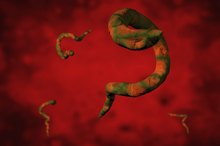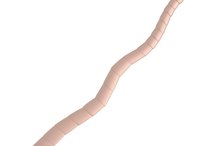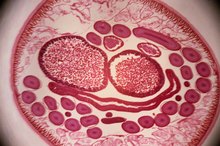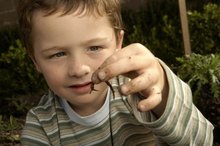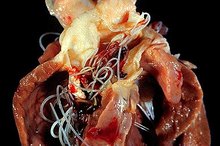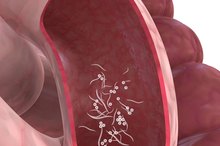Over-the-Counter Remedy for Tapeworms in Humans
Several species of tapeworms are capable of infesting human intestines without causing symptoms to announce their presence 1. A tapeworm is a flat, ribbon-like parasite that uses hooks on its head to attach to the wall of a human intestine. Body segments, called proglottids, contain eggs that break off and travel throughout the human body. Tapeworms can live in the human body for up to 30 years and can grow to be 100 feet long. Tapeworms are hermaphrodites, having both male and female reproductive organs.
If you are experiencing serious medical symptoms, seek emergency treatment immediately.
Growth Cycle
A cow, pig, fish or human may consume water containing tapeworm embryos. Tapeworm embryos are adventurous and destructive creatures that typically do not develop into adult tapeworms. Embryos bore through the animal’s abdominal lining and enter the blood stream where they travel to major organs and muscles. Once they find a cozy home they encase themselves in a fluid sac, known as a cyst, and remain there until eaten by another animal or human. This is why it is important to cook meat thoroughly.
- A cow, pig, fish or human may consume water containing tapeworm embryos.
- Once they find a cozy home they encase themselves in a fluid sac, known as a cyst, and remain there until eaten by another animal or human.
Symptoms
Signs of Intestinal Worms in Humans
Learn More
A human who has ingested embryos will not usually have any symptoms and the embryos go unnoticed until an autopsy is performed after death. The presence of tapeworm embryos in human organs and muscle tissues can cause an infection known as cysticerosis. In a rare number of cases, the embryos infect the central nervous system, causing neurocysticerosis, a fatal condition with symptoms of neurological damage and seizures.
The occasional tapeworm that makes it to the human intestine is capable of hatching and becoming a full-grown tapeworm. If this happens, you may notice abdominal discomfort, diarrhea, constipation or malnutrition. Headless tapeworm segments may be noticed in the toilet following a bowel movement or on undergarments. At this point, medicinal treatment is necessary.
- A human who has ingested embryos will not usually have any symptoms and the embryos go unnoticed until an autopsy is performed after death.
- In a rare number of cases, the embryos infect the central nervous system, causing neurocysticerosis, a fatal condition with symptoms of neurological damage and seizures.
Treatments
Although many over-the-counter medications are available for pets, it is best to visit your doctor when you realize you are infected with a full-grown tapeworm. An over-the-counter herbal colon cleanser may help reduce symptoms, but as long as the worm's head is attached to your intestinal wall, it will continue to grow and you will continue to experience problems.
At this point, it is extremely likely that you have tapeworm cysts throughout your body as well. Your doctor will perform an antibody test to identify the infection. If you are experiencing neurological symptoms, the cysts can be located with an MRI. Two prescription medications, praziquantel and albendazole, are required to rid the body of embryotic tapeworm cysts.
- Although many over-the-counter medications are available for pets, it is best to visit your doctor when you realize you are infected with a full-grown tapeworm.
- An over-the-counter herbal colon cleanser may help reduce symptoms, but as long as the worm's head is attached to your intestinal wall, it will continue to grow and you will continue to experience problems.
Prevention
What Are the Effects of Tapeworms in Humans?
Learn More
Prevention is the key to avoiding tapeworms. Avoid undercooked meat and fish; cook at a minimum of 150 degrees. Freeze meat and fish for 12 to 24 hours prior to cooking. Wash your hands before and after handling meat, eating and using the toilet. If anyone in your household, including pets, has been diagnosed as having tapeworms, everyone should be tested for them.
- Prevention is the key to avoiding tapeworms.
- Avoid undercooked meat and fish; cook at a minimum of 150 degrees.
Related Articles
References
- Puristat: Signs and Symptoms of Human Intestinal Tapeworms
- Centers for Disease Control and Prevention. Parasites - Cysticercosis. Updated July 31, 2019.
- Centers for Disease Control and Prevention. Parasites - Taeniasis. Updated January 10, 2013.
- García HH, Gonzalez AE, Evans CA, Gilman RH; Cysticercosis Working Group in Peru. Taenia solium cysticercosis. Lancet. 2003;362(9383):547-556. doi:10.1016/S0140-6736(03)14117-7
- Wakelin D. Helminths: Pathogenesis and Defenses. In: Baron S, editor. Medical Microbiology. 4th edition. Galveston, TX: University of Texas Medical Branch at Galveston; 1996.
- Bhattacharjee HK, Ramman TR, Agarwal L, Nain M, Thomas S. Isolated cysticercosis of the breast masquerading as a breast tumour: report of a case and review of literature. Ann Trop Med Parasitol. 2011;105(6):455-461. doi:10.1179/1364859411Y.0000000039
- Nash TE, Garcia HH. Diagnosis and treatment of neurocysticercosis. Nat Rev Neurol. 2011;7(10):584-594. doi:10.1038/nrneurol.2011.135
- Scholz T, Garcia HH, Kuchta R, Wicht B. Update on the human broad tapeworm (genus diphyllobothrium), including clinical relevance. Clin Microbiol Rev. 2009;22(1):146-160. doi:10.1128/CMR.00033-08
- Global Health – Division of Parasitic Diseases. "Diphyllobothrium latum (and other species) FAQs." Centers for Disease Control and Prevention. 10 Jan 2012.
- Global Health – Division of Parasitic Diseases. "Taeniasis FAQs." Centers for Disease Control and Prevention. 10 Jan 2013.
- Pearson R. "Taenia Solium (Pork Tapeworm) Infection and Cysticercosis.” Merck Manual Professional Edition. Aug 2016.
- Prescribers’ Digital Reference. "Praziquantel - Drug Summary.” PDR, LLC. 2018
- U.S. Department of Health and Human Services. "Safe Food Handling: What You Need to Know.” U.S. Food and Drug Administration. 30 Nov 2017.
